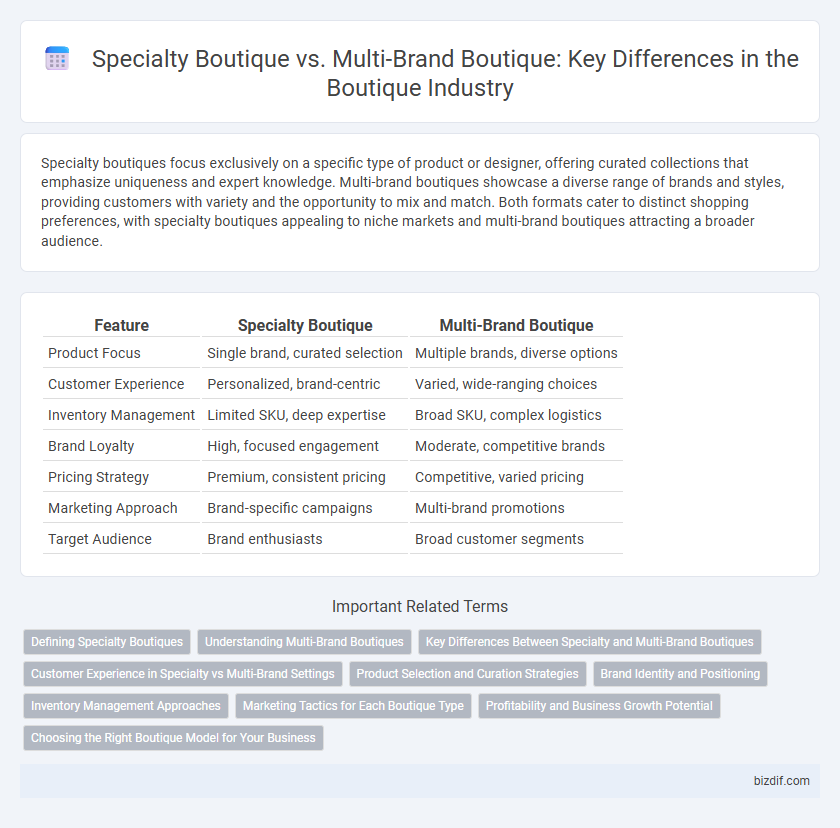Specialty boutiques focus exclusively on a specific type of product or designer, offering curated collections that emphasize uniqueness and expert knowledge. Multi-brand boutiques showcase a diverse range of brands and styles, providing customers with variety and the opportunity to mix and match. Both formats cater to distinct shopping preferences, with specialty boutiques appealing to niche markets and multi-brand boutiques attracting a broader audience.
Table of Comparison
| Feature | Specialty Boutique | Multi-Brand Boutique |
|---|---|---|
| Product Focus | Single brand, curated selection | Multiple brands, diverse options |
| Customer Experience | Personalized, brand-centric | Varied, wide-ranging choices |
| Inventory Management | Limited SKU, deep expertise | Broad SKU, complex logistics |
| Brand Loyalty | High, focused engagement | Moderate, competitive brands |
| Pricing Strategy | Premium, consistent pricing | Competitive, varied pricing |
| Marketing Approach | Brand-specific campaigns | Multi-brand promotions |
| Target Audience | Brand enthusiasts | Broad customer segments |
Defining Specialty Boutiques
Specialty boutiques focus on curating a distinct selection of products centered around a specific category, such as luxury handbags or artisanal jewelry, offering targeted expertise and personalized customer service. These boutiques differentiate themselves through exclusive inventory, often sourced directly from niche designers or limited-edition collections, creating a unique shopping experience. In contrast, multi-brand boutiques carry a broader range of brands across various categories, prioritizing variety over depth in specialized knowledge.
Understanding Multi-Brand Boutiques
Multi-brand boutiques curate diverse collections by offering products from various designers, providing customers with a wide range of styles and price points under one roof. These boutiques emphasize variety and trend responsiveness, attracting shoppers who seek unique, carefully selected items without being tied to a single brand identity. Understanding multi-brand boutiques reveals their role in adapting to consumer preferences while supporting emerging and established designers alike.
Key Differences Between Specialty and Multi-Brand Boutiques
Specialty boutiques focus exclusively on a specific category or brand, offering curated, in-depth expertise and a unique shopping experience tailored to niche markets. Multi-brand boutiques stock a variety of brands and product categories, emphasizing diversity and broad consumer appeal over exclusivity. The key difference lies in product variety and customer targeting, with specialty boutiques delivering focused, brand-centric selections while multi-brand boutiques prioritize variety and choice.
Customer Experience in Specialty vs Multi-Brand Settings
Specialty boutiques offer a highly personalized customer experience by focusing on curated product selections and expert knowledge within a specific category, ensuring tailored service and deeper brand engagement. Multi-brand boutiques provide diverse product options, appealing to broader tastes but often with less specialized attention, which can affect the depth of customer interactions. The heightened expertise and focused ambiance of specialty boutiques typically lead to stronger customer loyalty and satisfaction compared to the generalized approach found in multi-brand settings.
Product Selection and Curation Strategies
Specialty boutiques concentrate on a narrow product range, allowing for deep expertise and highly curated selections tailored to specific customer preferences. Multi-brand boutiques offer a diverse array of products from various designers, prioritizing variety and trend responsiveness to attract a broader clientele. Product selection in specialty boutiques hinges on unique, exclusive items, while multi-brand boutiques leverage brand diversity to create comprehensive shopping experiences.
Brand Identity and Positioning
Specialty boutiques focus on a singular brand identity, creating a cohesive and immersive experience that emphasizes the unique values and aesthetics of one label. Multi-brand boutiques offer diverse brand positioning by curating collections from various designers, appealing to a broader audience with varied tastes. Brand identity in specialty boutiques is reinforced by exclusivity, while multi-brand boutiques leverage variety to establish their market niche.
Inventory Management Approaches
Specialty boutiques focus on curated, niche inventory tailored to a specific style or customer segment, enabling precise stock control and deeper product expertise. Multi-brand boutiques manage diverse inventories from multiple labels, requiring robust tracking systems and flexible allocation to balance variety and availability. Effective inventory management in both settings relies on data analytics to optimize stock levels, minimize overstock, and ensure a seamless shopping experience.
Marketing Tactics for Each Boutique Type
Specialty boutiques leverage targeted marketing tactics that emphasize unique product stories, personalized customer experiences, and niche social media campaigns to build brand loyalty. Multi-brand boutiques utilize broad-spectrum strategies, including influencer partnerships, diversified promotional offers, and omnichannel advertising to attract a wider audience and showcase diverse merchandise. Both boutique types optimize SEO by integrating relevant keywords tailored to their product focus and customer demographics.
Profitability and Business Growth Potential
Specialty boutiques typically achieve higher profitability by focusing on niche markets with targeted products, resulting in strong brand loyalty and premium pricing opportunities. Multi-brand boutiques benefit from diversified product offerings, attracting a broader customer base and enabling more consistent revenue streams. Business growth potential in specialty boutiques hinges on deep market expertise and exclusive inventory, while multi-brand boutiques can scale faster through varied merchandising and flexible sourcing strategies.
Choosing the Right Boutique Model for Your Business
Specialty boutiques concentrate on a single product category or niche, offering deep expertise and a curated selection that appeals to a targeted customer base. Multi-brand boutiques feature diverse product lines from various brands, providing variety and attracting a broader audience. Selecting the right boutique model depends on market demand, brand positioning, and business goals, with specialty boutiques excelling in brand loyalty and expertise while multi-brand boutiques benefit from wider appeal and product flexibility.
Specialty Boutique vs Multi-Brand Boutique Infographic

 bizdif.com
bizdif.com